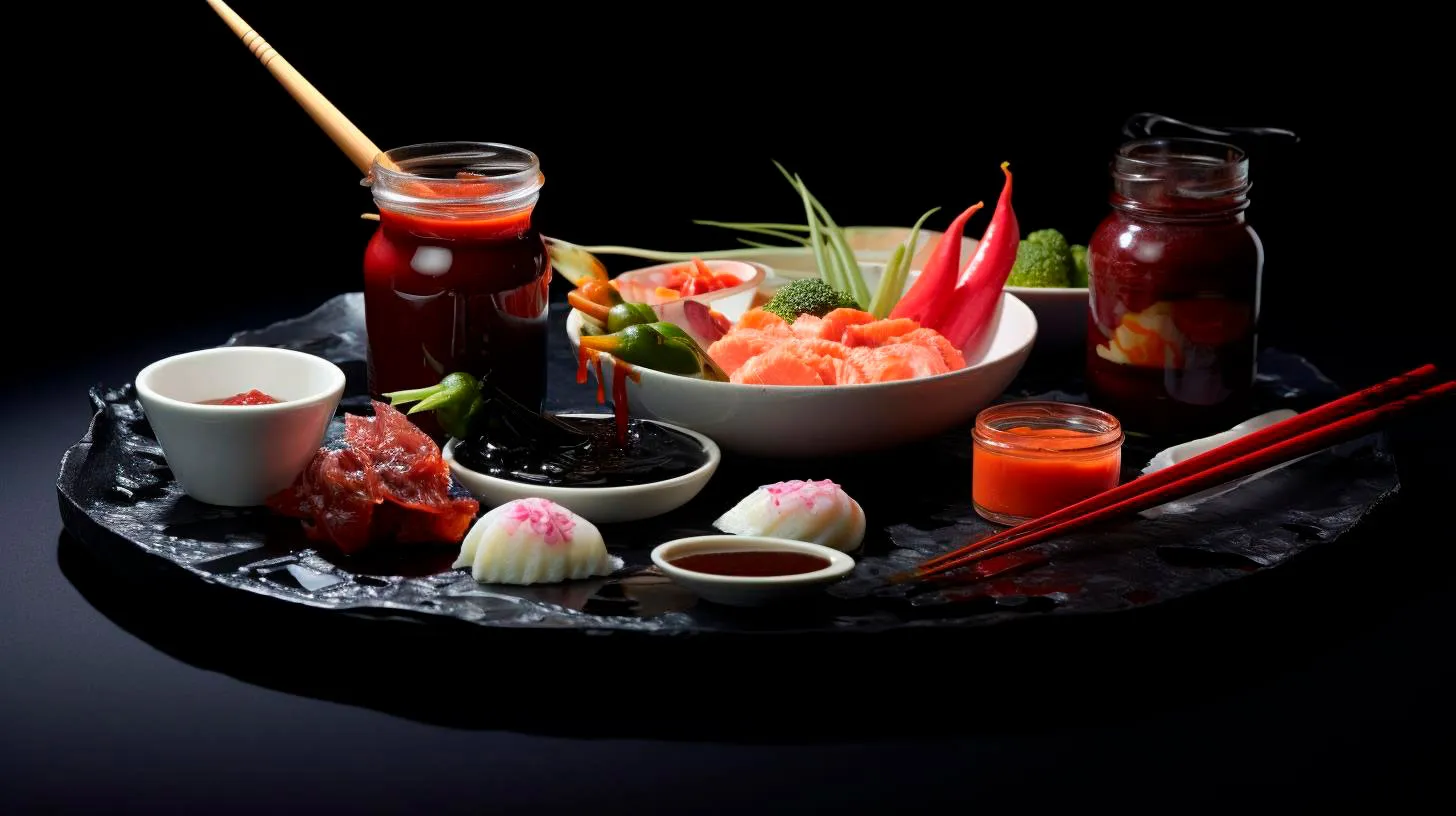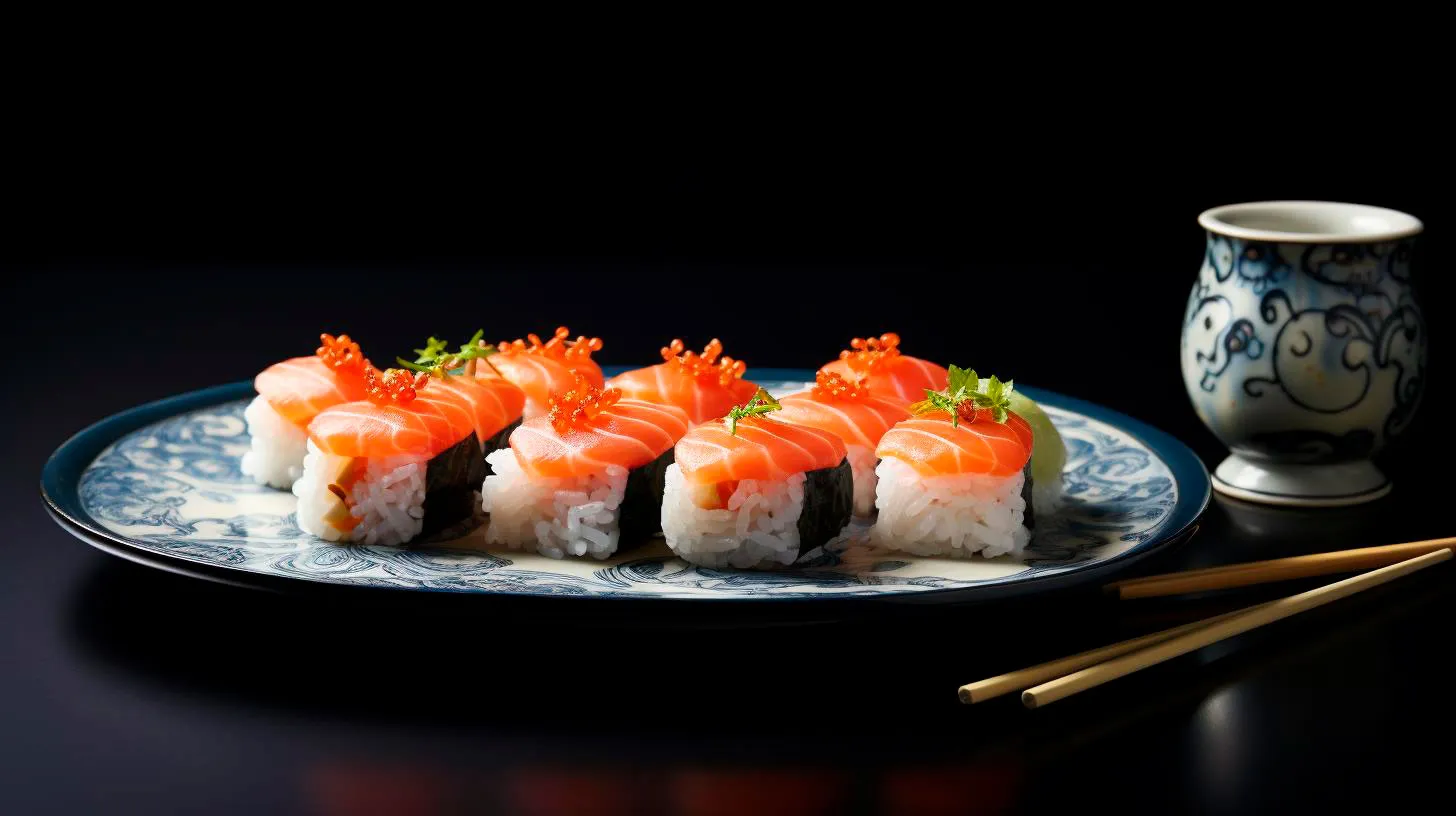Understanding the Art of Selecting Premium Sushi Ingredients
In this article, we will dive deep into the world of sushi ingredients and explore the key factors to consider when choosing them.
The Importance of Freshness
Sushi is all about freshness. From the fish to the rice, every ingredient needs to be fresh to ensure the best possible taste. Here are some key points to remember:
- Always source your seafood from reliable suppliers who prioritize freshness. Freshness guarantees a distinct flavor and pleasant texture.
- Look for sushi-grade fish, which refers to fish that is safe to be consumed raw. Sushi-grade fish undergoes strict quality control and has been frozen at extremely low temperatures to kill parasites.
- Keep an eye out for any signs of aging or discoloration on the fish. The gills should be red and the skin should be shiny, indicating that the fish is fresh.
Remember, when it comes to sushi, freshness is non-negotiable. Investing in premium, fresh ingredients will elevate your sushi-making game.
Sourcing Sustainable Ingredients
In recent years, sustainability has become a crucial factor in the culinary world. Sustainability ensures that we protect the environment and maintain the availability of ingredients for future generations. Here’s why sourcing sustainable ingredients for sushi is important:
- Choose fish and other seafood that are sourced responsibly to support sustainable fishing practices. Look for certifications such as MSC (Marine Stewardship Council) to ensure you are making sustainable choices.
- Opt for local and seasonal ingredients whenever possible. This not only supports local fishermen and suppliers but also reduces the carbon footprint associated with long-distance transportation.
- By selecting sustainable ingredients, you contribute to the conservation of marine ecosystems and help maintain biodiversity in our oceans.
Remember, sustainability is not just a trend, but a responsibility we all share. Selecting sustainable ingredients for your sushi not only benefits the environment but also reflects positively on your culinary values.
Quality Rice for Perfect Sushi
While the fish takes the spotlight in sushi, the quality of the rice should not be overlooked. Here are some important points to consider when choosing the perfect sushi rice:
- Use short-grain rice specifically labeled as sushi rice. This type of rice has a higher starch content, which gives it a stickier texture, making it easier to shape into rolls or nigiri.
- Look for rice that has been properly polished. The polishing process removes the outer layer of the rice grain, resulting in a clean and shiny appearance.
- Avoid using rice that is overly mushy or hard in texture. The ideal sushi rice should have a slightly chewy texture and hold its shape well when formed into sushi.
Remember, the rice is the foundation of your sushi. Using high-quality sushi rice ensures that your sushi rolls and nigiri have the perfect texture and flavor balance.
Flavorful Sushi Additions
While the fish and rice are fundamental to sushi, the art of selecting premium ingredients goes beyond these basics. Here are some flavorful additions that can take your sushi to the next level:
- Wasabi: This spicy condiment adds a burst of flavor and enhances the overall taste of sushi.
- Ginger: Pickled ginger, known as gari, cleanses the palate between each bite, enabling you to fully savor the flavors of different sushi pieces.
- Soy Sauce: Opt for high-quality soy sauce to accompany your sushi. The right soy sauce can bring out the umami flavors in the fish and complement the overall taste.
- Sesame Seeds: Toasted sesame seeds sprinkled on top of sushi rolls add a delightful nutty flavor and provide a pleasing texture.
Remember, these flavorful additions enhance the sushi experience, so be sure to choose high-quality options that complement the overall taste profile.
To Sum It Up
Selecting premium sushi ingredients involves a combination of factors, including freshness, sustainability, rice quality, and flavorful additions. By prioritizing these aspects, you ensure that your sushi creations are of the highest standard. Here are the key takeaways:
- Always choose fresh and sushi-grade fish to guarantee the best taste and texture.
- Source sustainable ingredients to support responsible fishing practices and protect the environment.
- Use high-quality sushi rice to achieve the perfect texture and flavor balance in your sushi.
- Experiment with flavorful additions like wasabi, ginger, soy sauce, and sesame seeds to elevate the overall taste experience.
Remember, in the art of sushi-making, premium ingredients are the key to success. So, go ahead and explore the world of sushi, experiment with different ingredients, and create your own culinary masterpieces!
Secrets Revealed: How Sushi Chefs Identify the Freshest Catch
In this article, we will unveil some of the secrets behind a sushi chef’s ability to discern the freshest fish available.
The Importance of Fresh Fish in Sushi
Before diving into the secrets, let’s understand why fresh fish is crucial in the world of sushi. The delicate nature of sushi demands top-quality ingredients to deliver an unforgettable dining experience. When fish is caught, it begins undergoing enzymatic and bacterial changes that affect its texture, flavor, and overall quality. Hence, only the freshest fish can achieve the melt-in-your-mouth perfection that sushi aficionados seek.
Secrets Behind Identifying the Freshest Catch
1. Visual Cues: Sushi chefs rely on their keen eyesight to identify the freshness of the fish. They examine the color and texture of the skin, observing if it appears vibrant, glossy, and has a natural sheen. Reddish-pink hues are often preferred, indicating high-quality tuna. Furthermore, a shiny and firm surface free from blemishes or discoloration is usually an excellent indicator of freshness.
2. Smell Test: Another crucial factor sushi chefs consider is the aroma of the fish. Fresh fish should have a pleasant and clean smell reminiscent of the ocean. A strong, pungent odor is a clear indication of fish past its prime. It is through their olfactory senses that sushi chefs can detect subtle differences, ensuring only the freshest catches make their way onto the sushi counter.
3. Firmness and Texture: When touched, fresh fish should feel firm and slightly bouncy. Sushi chefs carefully assess the texture of the flesh to determine its quality. They look for fish that has a balance between firmness and tenderness, as overly soft or mushy texture signals compromised freshness.
4. Eye Clarity: The clarity of the fish’s eyes is an important indicator of its freshness. Clear, bright eyes demonstrate that the fish is newly caught. In contrast, cloudy or discolored eyes suggest aging and a decline in quality. Sushi chefs pay meticulous attention to this detail when selecting the fish for their creations.
5. Cold Chain Management: The sushi industry has stringent cold chain management practices in place. Temperature control during transportation is essential to preserve fish freshness. Sushi chefs are meticulous about sourcing from trusted suppliers who follow these guidelines to ensure that the fish they receive is delivered under ideal conditions.
6. Establishing Relationships with Suppliers: Experienced sushi chefs often build long-standing relationships with reliable suppliers. This connection allows them to have first access to the freshest catch. By working closely with trusted suppliers, they can maintain a consistent supply of high-quality fish, ensuring that their customers are served only the best.
The Benefits Beyond Taste
While the primary aim of sushi chefs is to deliver a flavorful experience, the emphasis on freshness also provides additional benefits:
- Enhanced Food Safety: Fresh fish minimizes the risk of foodborne illnesses associated with improperly stored or mishandled seafood.
- Nutritional Value: The fresher the fish, the higher its nutritional value. Consuming sushi made with fresh catch ensures you receive the optimum health benefits.
- Enjoyment of Textures: Fresh fish retains its natural textures, allowing you to enjoy the unique mouthfeel of each type of sushi.
- Respect for Tradition: Sushi is deeply rooted in Japanese culture, and the emphasis on fresh ingredients honors the traditions and authenticity of this beloved cuisine.
Final Thoughts
Sushi chefs possess a remarkable ability to identify the freshest catch, enabling them to create culinary delights that leave diners in awe. Through visual cues, smell tests, and a comprehensive understanding of fish quality, these skilled artisans ensure each bite is a journey of flavors. By prioritizing freshness, sushi chefs uphold the standards and traditions of sushi while providing an unmatched dining experience for sushi lovers everywhere.
Mastering the Craft Expert Advice on Selecting Grade-A Seafood
The Importance of Quality Seafood
Seafood is not only a delectable treat but also a valuable source of vital nutrients such as omega-3 fatty acids, vitamins, and minerals. However, the quality of seafood can vary significantly, and consuming low-quality products can have negative consequences on both taste and health.
Below, we have outlined the key features and advantages of selecting grade-A seafood:
- Superior Taste: Grade-A seafood is known for its delicious flavor and rich texture, providing an exceptional dining experience.
- Health Benefits: High-quality seafood is packed with essential nutrients, promoting heart health, brain function, and overall well-being.
- Sustainability: By choosing grade-A seafood, you support sustainable fishing practices that help preserve our oceans and marine life.
- Food Safety: Premium seafood undergoes strict quality controls, ensuring it is safe for consumption and reducing the risk of foodborne illnesses.
Expert Tips for Selecting Grade-A Seafood
1. Freshness is Key
When it comes to seafood, freshness is paramount. Follow these tips to identify the freshest catch:
- Look for clear and bright eyes in fish, shrimp, and other whole specimens.
- Check for firm and elastic flesh that bounces back when pressed.
- Always trust your nose – fresh seafood should have a mild, pleasant smell of the ocean, not a strong, fishy odor.
- If available, purchase seafood directly from reputable local fishermen or trusted seafood markets.
2. Consider the Source
Knowing the source of your seafood is crucial for ensuring its quality and sustainability. Consider the following factors:
- Opt for wild-caught seafood whenever possible, as it often has better flavor and a higher nutritional content compared to farm-raised alternatives.
- Look for labels such as “sustainable seafood” or certifications like the Marine Stewardship Council (MSC), which signify that the seafood has been responsibly sourced.
- Stay informed about seasonality to choose seafood that is available during its peak harvest time.
3. Quality Indicators
When examining seafood, be on the lookout for the following quality indicators:
- Color: Fresh fish should have vibrant, shiny colors specific to their species.
- Scales and Skin: The scales should be intact and tightly adhered to the skin, while the skin should be moist and vibrant.
- Texture: Shellfish, such as clams and oysters, should have tightly closed shells. Likewise, lobsters and crabs should feel heavy for their size.
Key Takeaways
Mastering the craft of selecting grade-A seafood is a journey filled with flavors and experiences. Remember these key takeaways on your quest for the finest catch:
- Grade-A seafood offers superior taste, health benefits, and support for sustainable fishing practices.
- Freshness is crucial – look for clear eyes, firm flesh, and a mild ocean aroma.
- Consider the source of your seafood and opt for wild-caught options with sustainability certifications.
- Pay attention to quality indicators, such as color, scales and skin condition, and texture.
By following these expert tips, you will be well on your way to selecting and enjoying only the best grade-A seafood for your culinary adventures. Bon appétit!
Insider Tips Choosing the Finest Fish for Exceptional Sushi
In this article, we will provide you with insider tips on choosing the finest fish for exceptional sushi.
The Importance of Freshness
One of the most important factors when selecting fish for sushi is freshness. Fresh fish not only tastes better but also reduces the risk of foodborne illnesses. When fish is caught, it begins to deteriorate rapidly, and sushi-grade fish must be handled and stored properly to ensure maximum freshness. The best sushi chefs source their fish from trusted suppliers who prioritize quality and freshness.
Here are some key takeaways when it comes to freshness:
- Look for fish that is firm to the touch and has a bright color.
- Check for clear and bright eyes, a sign of freshness.
- Smell the fish – it should have a clean and ocean-like scent, not a strong fishy odor.
- Ask your sushi chef about their fish sourcing and handling practices.
Remember, freshness is the cornerstone of exceptional sushi!
Popular Fish for Sushi
Now let’s dive into some popular fish choices that are widely used in sushi preparation:
1. Tuna (Maguro)
Tuna is a staple of sushi menus worldwide and is often considered the king of sushi fish. It has a firm texture and a rich, buttery taste that melts in your mouth. Tuna is classified into different cuts, with the most prized being the fatty belly part known as toro. It is important to note that excessive consumption of certain types of tuna, such as bluefin tuna, can be detrimental to the environment. Opt for sustainable alternatives like yellowfin or albacore tuna.
2. Salmon (Sake)
Salmon has gained immense popularity in recent years due to its buttery texture and mild flavor. It is rich in omega-3 fatty acids, which are beneficial for heart health. When choosing salmon for sushi, make sure it is sushi-grade and sourced from reputable suppliers.
3. Yellowtail (Hamachi)
Yellowtail is a favorite among sushi enthusiasts for its delicate flavor and buttery texture. It is often served as sashimi but works equally well in sushi rolls. Look for yellowtail that is bright and translucent, with a clean scent.
4. Shrimp (Ebi)
Shrimp is a versatile option that adds a sweet and succulent flavor to sushi. It can be served cooked, boiled, or even raw as shrimp sushi. Choose shrimp that is firm, with a shiny exterior and a slight natural sweetness.
5. Flounder (Hirame)
Flounder is a mild and tender white fish that is commonly used in sushi. It has a delicate flavor and a soft texture that pairs well with other ingredients. Look for flounder with clear, bright eyes and firm flesh.
Conclusion
Choosing the finest fish is essential for creating exceptional sushi. Remember to prioritize freshness and source your fish from reputable suppliers. Tuna, salmon, yellowtail, shrimp, and flounder are just a few examples of the fish commonly used in sushi – each bringing its unique flavors and textures to the culinary experience.
By following these insider tips and being mindful of the quality of the fish you select, you can elevate your sushi-making skills and enjoy truly exceptional sushi at home or in your favorite sushi restaurant.



